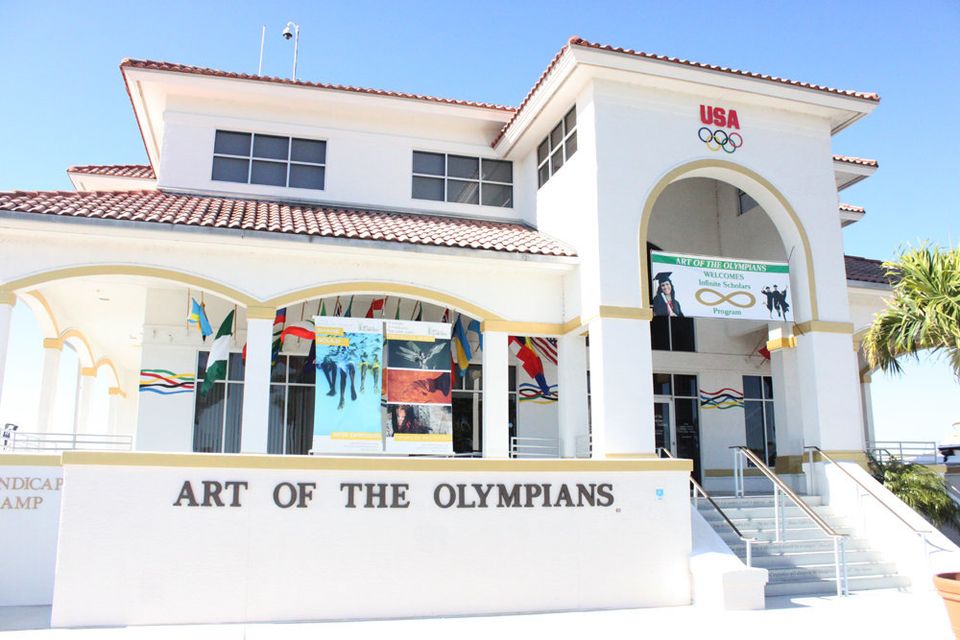Though Fort Myers, Florida, is a hub for neither creativity -- on an art world map it would like sit beneath the words "Here Be Watercolors" -- nor athletics, the newest museum in town pays tribute to both and, it certainly could be argued, neither. It may be both America's strangest museum and, at the same time, the most American museum imaginable. It is a damn confusing place.
The Art of the Olympians sits at the end of a yacht basin pier near where endless sedans with tinted windows and outdated campaign stickers climb the Calloosahatchee Bridge toward Cape Coral. The building is bland yet inviting in the way that so many Floridian buildings are bland but inviting, all stucco and whitewash. What sits inside is harder to describe because the museum isn't devoted to Olympic posters or paintings or even uniforms for that matter -- though it has all those things. Instead, the museum is designed as a tribute to the artistic endeavors of former Olympians.
If that seems arbitrary it is precisely because it is incredibly arbitrary. There exists no museum expressly devoted to the artistic endeavors of any other group of people whose shared characteristic was prior employment outside the arts. There is no Art of the Plumbers nor Art of the Relief Pitchers nor Art of the Pool Cleaners nor Art of the Hairdressers. This is not because employment in any one of these professions indicates a lack of artistic ability -- Gauguin sold tarpaulins -- but because there is no apparent correlation betweens these careers and more avant garde endeavors.
The hypothesis offered by the museum's mere existence is that Olympians are simply better at everything. Unfortunately, the evidence inside the museum doesn't support this conclusion.
To describe the collection as uneven would be charitable. There are sculptures and paintings, a smidge of graphic design and even engravings. The vast majority of the work is abstract, presumably because the athletes-cum-artists couldn't achieve verisimilitude, and the common preoccupation is the human form, which makes a great deal of sense.
Unfortunately, there are really only two artists on display worth much consideration. One, Marco Pantani, has contributed a self portrait that seems to capture the spirit of competition. The other, Bob Beamon, has hung simple but engaging graphic work. Beamon, who won gold in the long jump at the 1968 Olympics in Mexico City, runs the museum. He inherited the idea from the great discus thrower and lesser-known abstract painter Al Oerter, who is depicted in a video installation combining his two talents by throwing a paint-dipped disc at a canvas.
This is all very silly, but also very interesting when one listens to the voiceover in the video installation explaining that what is great about Olympians is that they give whatever they're doing their all; regardless of whether they are racing or sculpting, they leave it on the field.
Here's the thing: Sports and the Arts aren't actually about trying hard, at least not at a high level. They are both about actual excellence. The striving part -- think about savants like Pablo Picasso or Usain Bolt -- is hardly mandatory.
Which means that Art of the Olympians is probably the only art museum in America, perhaps the world, that is devoted to a group of artists less notable for their art than for giving it their all. It is both a tribute to the way we lionize our athletes and an actual incarnation of the fictional, effort-based meritocracy we like to describe to children. Like every other museum, Art of the Olympians shows the work of people who have achieved great things. Unlike other museums, it doesn't show great things. It is basically just a random cross-section of art by a group of people that isn't particularly artistically talented.
And that is why everyone should go see Art of the Olympians -- everyone in this part of Florida, anyway. This is the museum by which all other museums should be measured. It is so perfectly average that it ought to be used as a unit of measurement for better collections. The Metropolitan Museum of Art: 10 AOTOs. The National Portrait Gallery: 8 AOTOs. So on and so forth.
Though it doesn't achieve kitsch, Art of the Olympians does achieve something unique: uniqueness. There is no other place like it, no other athlete running in this particular race.
When it comes to art, this place wins by default.
